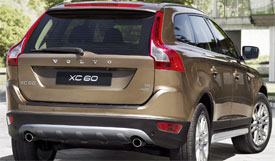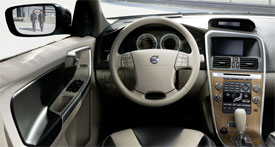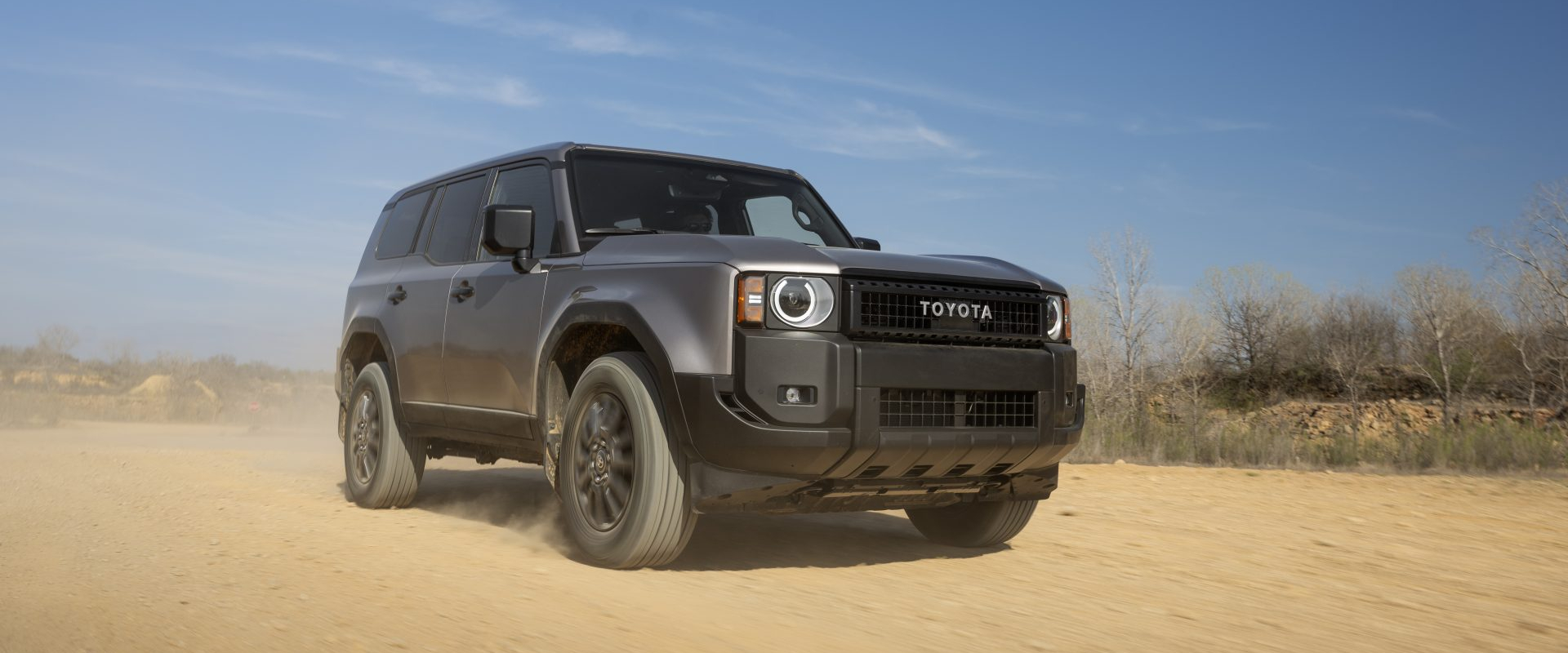2010 Volvo XC60
For more than a generation, Volvo has built its American reputation on two things: safety and its premium station wagons. Even when wagons fell out of favor at other brands, they remained an attraction for Volvo purists. But, some of those fans did defect to the Volvo XC90 Crossover. Now, with the all-new XC60, it’s possible that a lot more just might be tempted to follow suit.
The 2010 Volvo XC60 may be a late entry into the premium compact-to-midsize crossover race, but don’t expect this stylish and sporty utility to trail behind for too long.
The XC60 will compete directly with the BMW X3, the Acura RDX, and the Mercedes Benz GLK.
Styling hints of the XC70 and XC90, but from there the familiar Volvo DNA runs a little wild. The modified trapezoidal grille is flanked by dramatically flared headlamps.
The XC60’s wedge-like forward-leaning profile makes this crossover look like it’s ready to pounce. A muscular shoulder line, lower body cladding, and a coupe-like greenhouse all add to its athletic presence, as do the 18 or 19-inch wheels.
Further distinction comes from a well-sculpted back-end. But the most eye-catching cue is, no doubt, the exaggerated boomerang-like LED tail lamp design.
Offered currently as a single T6 all-wheel-drive model, the XC60 is moved by Volvo’s familiar 3.0-liter turbocharged inline-6, producing 281 horsepower and 295 pound-feet of torque. Max towing capacity is a reasonable 3,300 pounds.
 Power is managed by a six-speed automatic with manual mode which feeds Volvo’s latest Haldex 4 all-wheel drive system with Instant Traction torque transfer. For the more adventurous, Hill Descent Control is also available.
Power is managed by a six-speed automatic with manual mode which feeds Volvo’s latest Haldex 4 all-wheel drive system with Instant Traction torque transfer. For the more adventurous, Hill Descent Control is also available.
But this wouldn’t be a Volvo road test without a truly novel safety breakthrough. That would be Volvo’s City Safety System. City Safety is a low-speed rear collision avoidance system that utilizes an infrared laser in the rear view mirror to detect a stopped car ahead. City Safety will automatically apply the brakes at speeds up to 18 miles-per-hour to prevent a crash.
We don’t recommend you trying City Safety out just for grins like we did since it doesn’t activate until the last possible second. And stops are quite abrupt and really get your attention.
At the track, the XC60 also impressed us with its quickness. 0 to 60 in just 6.7 seconds and the quarter-mile in 15.2 seconds at 97 miles-per- hour. This crossover has a strong, smooth pull all the way up to the redline. Shifts, however, were not as quick as we would have liked them to be.
Sharing some chassis elements with the V70 and S80, suspension is front MacPherson strut/rear multi-link, with a three-mode active chassis option coming later. Aiding cornering now is an enhanced Dynamic Stability Control System, Roll Stability Control, and for towing maneuvers, new optional Trailer Stability Assist.
Maybe we expected too much, since this is a luxury car, but ride definitely rules over handling. The XC60 exhibits a top-heavy feel and reached its limits somewhat quickly.
Braking redeemed the XC60. Four-channel all-disc ABS with Brake Assist delivered average stops from 60 of a short 127 feet. They were solid and straight with minimal nose dive.
On everyday roads, the ride was soft and plush, perfect for Monday-through-Friday commutes. But with 9.1 inches of ground clearance, taking the XC60 off the pavement for a weekend adventure does not have to be a second thought.
 The interior of the five-passenger XC60 is a continuation of the clean and modern Scandinavian design we liked so much in the XC70 and C30. Gauges and controls are smartly laid-out and exude an artful sophistication.
The interior of the five-passenger XC60 is a continuation of the clean and modern Scandinavian design we liked so much in the XC70 and C30. Gauges and controls are smartly laid-out and exude an artful sophistication.
The XC60’s seats are well-contoured and supportive, featuring stitched seams and optional heat.
The slim, floating center stack design includes an available navigation screen that’s slightly angled toward the driver. It includes real-time traffic, and remote control.
There’s also a Rear Park Assist Camera packaged with the Nav system.
And not to be forgotten, our tester’s upgraded Dynaudio Premium Sound System with surround sound, for memorable listening enjoyment.
Other characteristic Volvo safety gear includes six airbags, anti-whiplash seats, and optional Lane Departure Warning.
The rear bench seat is fit for three, but it’s not the most spacious we’ve seen. Its 40/20/40 split, however, is family friendly, as are a pair of optional integrated child booster seats.
Cargo room is a generous 30.8 cubic feet with the seats up, and a very competitive 67.4 with the seats down.
Government Fuel Economy for this crossover is an underwhelming 16 city/22 highway on premium gas. We managed to get 20.6 miles-per-gallon in real-world driving.
Base pricing for the XC60 starts at $38,025. That’s less than a BMW X3, but more than the Acura RDX and the Mercedes-Benz GLK.
The eye-catching 2010 Volvo XC60 offers everything an upscale family could wish for - innovative safety, strong performance, true multi-purpose capabilities, and a comfortable, sophisticated cabin. For a company steeped in the tradition of the station wagon, the XC60 is a nice step up that doesn’t’ forget its roots.
Specifications
- Engine: 3.0-Liter Turbocharged Inline-6
- Horsepower: 281
- Torque: 295 Lb Feet
- 0-60 MPH: 6.7 Seconds
- 1/4 Mile: 15.2 Seconds @ 97 MPH
- 60-0 MPH: 127 Feet
- EPA: 16 MPG City/ 22 MPG Highway
- Mixed Loop: 20.6 MPG
2024 Toyota Land Cruiser
Toyota’s Go Anywhere Globetrotter Returns To U.S.
Every once in a while, we all need a reset. A time to get back to basics and prioritize the things that really matter. Well, for the Toyota Land Cruiser that time is now. So, let’s find out if that means bigger and better things for Toyota’s iconic off-roader.
The Toyota Land Cruiser’s status among the global off-road community is legendary, and it’s hard to imagine there’s any corner of the earth where a Land Cruiser hasn’t kicked up a little dust or mud. Well, 2024 sees the return of the Land Cruiser to the U.S. market after a 3-year hiatus, getting a major reset for the journey.
The reset comes mostly by no longer being based on the large three-row “300-series” chassis, but a new version of the smaller “200-series,” now known as the J250. As with the latest Tacoma, it uses the Tundra pickup’s full-size steel frame.
While the main Land Cruiser model, which goes by simply Land Cruiser, is packed full of luxury and convenience features, there is also a stripped-down model known as the 1958, honoring the first year the Land Cruiser made landfall here in North America. And it is that 1958 we have here, and we were glad to see it, as it also celebrates the original’s back-to-basics approach as a blank canvas for you to personalize as you tackle more and more adventures.
Not that it’s fully stripped down, as 8-inch touchscreen infotainment, a 7-inch full-color multi-information display, and automatic climate control are still standard. Plus, some seriously durable materials, and great heated cloth front seats that throw off some get serious 1990s Tacoma vibes.
But outside, there’s a definite lack of flashy trim and basic looking 18-inch wheels with Yokohama Geolander all-season tires; plus, big chunky bumpers and tilt-up back glass, which is a rarity that we appreciate. Though there is a little too much plastic in places that are sure to see some abuse if you do any significant off-roading.
It even feels a little rough around the edges, but for us it just adds to the rugged old-school utility vibe in a good way.
We did just that, both here in the Mid-Atlantic as well as in the California desert; and while there are some tech-forward driving aids, the actual hardware is in most cases plenty to get things done. That includes standard full-time dual-range four-wheel-drive, locking center and rear diffs, and 8.7-inches of ground clearance. A front stabilizer bar disconnect is also available to allow for increased articulation.
Who needs a V6 or even a V8 when you’ve got Toyota’s i-FORCE MAX setup at your disposal with 326 horsepower and 465 lb-ft of torque coming from a 2.4-liter turbo-four with an electric motor sandwiched between the engine and its eight-speed automatic transmission. Low speed torque delivery is impressive. It even feels a little rough around the edges, which may be a turn off to some, but for us it just adds to the rugged old-school utility vibe in a good way.
And it certainly feels quicker than an off roader needs to be, with an instant torque dump as soon as we eased on the throttle at our Mason Dixon test track; helping us get to 60 in 8.1 seconds and through the quarter-mile in 16.3 seconds at 86 mph. Considering the Land Cruiser’s terrain conquering mission, it behaved quite well in our handling course; it was plenty responsive to inputs, with less body roll than we expected and plenty of grip from the tires. The steering was light and quick but as expected didn’t provide much feel. Other than significant nosedive, braking performance was exceptional. Only 107-feet to panic stop us from 60 mph.
With the shift to the smaller size, there’s no more third row available, and cargo capacity now comes in at 46.2 cubic-feet with a max of a still healthy 82.1. Now, the best part of the Land Cruiser’s return is the entry price of $57,445. That’s about 30-grand less than what the last Land Cruiser went for back in 2021.
Whether it’s over the top fashion trends, mullets, or zombies; just when you think they’re dead, they come roaring back to life. Of course, we’re much happier to see the resurrection of this 2024 Toyota Land Cruiser than any of those things. Toyota is one brand that still recognizes the value of full-framed rugged rigs and has also acknowledged that sometimes less really is more. The Godfather of Toyota off-roading is back and better than ever.







